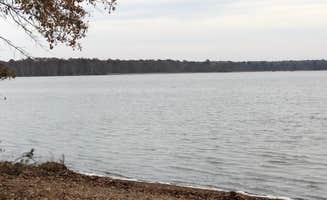Dispersed camping options near Lightfoot, Virginia include several Wildlife Management Areas (WMAs) with rustic sites along waterways. The region sits within Virginia's coastal plain at elevations below 100 feet, characterized by mixed hardwood forests and tidal marshes. Winter temperatures typically range from 30-50°F, while summer brings heat and humidity with temperatures regularly exceeding 85°F.
What to do
Fishing opportunities: Access points at Chickahominy Wildlife Management Area Site (WMA) provide excellent fishing spots where anglers can camp very close to the water. "I arrived with a small (18') trailer and put it within 5' of the water," notes one camper, highlighting the convenience for those combining fishing with camping.
Watch wildlife: The waterfront locations at Eagle Nest Lookout offer opportunities to observe river wildlife and waterfowl. One visitor described the scenery as "spectacular alongside the Chickahominy River and a great place for hiking."
Drone fishing: Some campers have observed this modern fishing technique at the waterfront sites. A camper noted seeing fellow visitors who "pulled up a 17 pounder and a 25 pounder using a drone to take their lure easy out" while someone else "caught a decent bass."
What campers like
Waterfront access: The proximity to water at Eagle Nest Lookout appeals to many visitors. One camper appreciated "car camping here 5 feet from the water" with "a large shoreline area to car camp and right up the hill is a nice tent site as well overlooking the river."
Multiple site options: The management areas offer various camping spots beyond just the riverside locations. A camper at Chickahominy WMA noted, "Basic parking spot in quiet location... It's 2 parking side by water and some other ones on the way while driving."
Elevated camping spots: The terrain provides both shoreline and higher elevation options. At one location, a camper described "a small knoll. At the top is an area about 20 feet wide covered in mature trees with a view of the James River."
What you should know
Permit and fee requirements: Virginia residents with hunting or fishing licenses receive free camping for up to 14 days, while others must purchase permits. As one camper at Ware Creek Wildlife Management Area noted, "Take advantage of your local wildlife areas" as they can provide affordable camping opportunities.
Trash issues: Multiple campers report having to clean up after previous visitors. One camper stated, "This site had some trash unfortunately. But the privacy and singularity of camping so close to the water made it a nice find."
Shooting range noise: The proximity to active shooting areas affects the sound environment. A camper warned, "Be aware that you will be able to hear the shooting range up till the evening. In my opinion these areas are not necessarily the best place for quiet secluded camping."
Weekend crowds: Weekends bring more activity from hunters, anglers, and recreational shooters. A visitor observed, "Weekends some hunters and shooting range close by in other side."
Tips for camping with families
Choose elevated sites for safety: For families with small children, the higher ground options may be safer than waterfront spots. At Eagle Nest Lookout, "There is a raised area—about 20' above the drivable area—that would be perfect for a campfire and a tent or two."
Pack all necessities: No facilities means bringing everything needed for your stay. Remember the principle described by one camper: "No water, no toilet, Pack it in, Pack out. LNT [Leave No Trace]."
Consider weekday visits: For a quieter experience with children, avoid weekends when shooting ranges are active. Weekdays typically see "less people fishing" and reduced activity at nearby ranges.
Tips from RVers
Small trailers only: The access roads and clearings can accommodate modest-sized trailers. As one RVer reported, "I arrived with a small (18') trailer" at Chickahominy Wildlife Management Area, indicating that larger rigs would likely find access and maneuverability difficult.
Scout locations first: If arriving with a trailer, consider a preliminary visit to assess access. "Got here late as the sun was going down. Camped in the RAV4. Will explore the area in the morning," suggesting the value of arriving with daylight hours to find suitable spots.
Prepare for self-sufficiency: With no hookups or facilities, RVers must be entirely self-contained. Plan water usage carefully and prepare waste management solutions before arrival.


